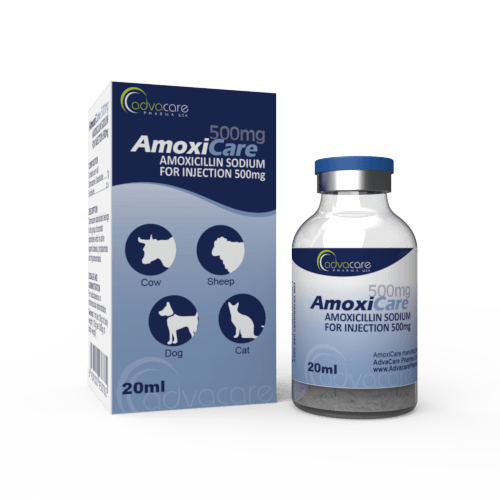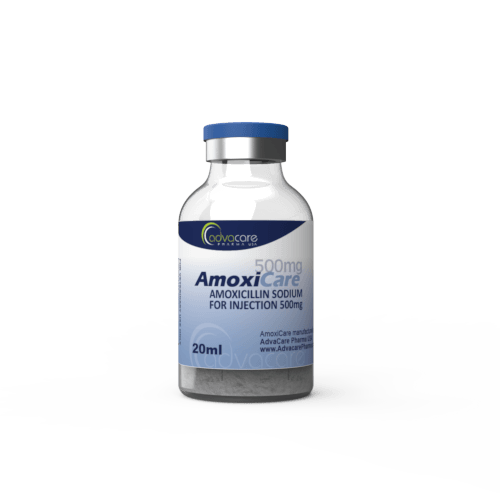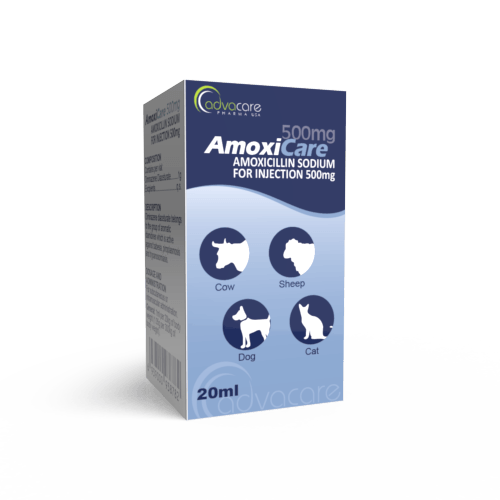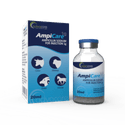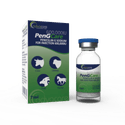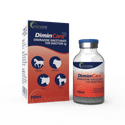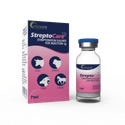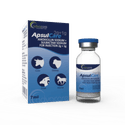- Home›
- Veterinary Pharmaceuticals›
- Veterinary Injections›
- Veterinary Powders for Injection›
- Amoxicillin Sodium for Injection
Amoxicillin Sodium for Injection
Dosage
Packaging
What is Amoxicillin Sodium?
Active Ingredients: Amoxicillin Sodium
Amoxicillin Sodium for Injection is a long-acting penicillin antibiotic drug used to treat a wide range of bacterial infections in livestock animals, pets, and horses. It is indicated for the treatment of skin infections, gastrointestinal tract infections, bone/joint infections, and many other types of infections. It is a beta-lactam antibiotic that has bactericidal properties by activating autolytic enzymes that destroy the bacteria cell wall.
Amoxicillin is well absorbed by the intestinal tract and is a safe, non-toxic option to treat susceptible infections. This form of amoxicillin sodium has been manufactured as a powder for reconstitution. It is intended to be mixed into its injectable form and then administered by a veterinary doctor or animal care specialist.
Amoxicillin is a moderate-spectrum, beta-lactam antibiotic used to treat bacterial infections caused by susceptible microorganisms. It works by inhibiting cell wall synthesis, which kills the bacteria.
When injected, Amoxicillin is easily distributed in the extracellular fluid in tissues, especially when inflammation is present. The antibiotic is partially excreted in urine and reaches the highest levels in urine.
It is important to note that this formulation of amoxicillin sodium is for veterinary purposes only. While AdvaCare Pharma offers many similar products that are available for human use, this particular medication should be prescribed by a veterinary doctor or animal care specialist for an animal.
This product is also available in the form of suspension for injection, and soluble powder.
Amoxicillin Sodium for Injection is a GMP-certified product that has been manufactured by AdvaCare. This medication is a part of our extensive catalog of veterinary supplies available for exportation. Our manufacturing facilities are located in China, India, and the USA.
Why are we a trusted Amoxicillin manufacturer?
AdvaCare Pharma is a leading GMP manufacturer of Amoxicillin Injection for veterinary use. Our company was established with the aim of providing excellent value to our veterinary distributors by concentrating on competitively priced, high-quality veterinary pharmaceuticals with market-tailored solutions.
Over the past 20 years, AdvaCare Pharma has proven to be a trusted Amoxicillin manufacturer and supplier of 100+ veterinary injections in over 65 countries.
Uses
What is Amoxicillin Sodium used for?
It's used to treat bacterial infections such as:
- respiratory tract infections (e.g. bronchopneumonia)
- genitourinary infections (e.g. cystitis, urethritis, pyelonephritis)
- skin and soft tissue infections (e.g. mastitis, abscess, cellulitis, wound infections)
- bone and joint infections (e.g. osteomyelitis)
In pigs, this medicine is prescribed for arthritis and meningitis caused by S. suis and secondary infections due to ear and tail-biting.
What animals can be treated with Amoxicillin Sodium for Injection?
This medicine is recommended for horses and livestock like cows, goats, and sheep. It's also used to treat companion animals like cats and dogs. Do not use Amoxicillin to treat rabbits, guinea pigs, chinchillas, hamsters, or other small mammals. It may cause enteritis or clostridial enterotoxemia in these animals. Enteritis involves inflammation of the intestines, while clostridial enterotoxemia involves toxins produced by certain Clostridium bacteria, most commonly Clostridium perfringens.
How is Amoxicillin Sodium for Injection used?
This medicine has been manufactured as a powder for reconstitution. It should be dissolved with sterile water. The reconstituted solution should be used within 20 minutes of reconstitution.
This medicine can be administered either by intravenous, subcutaneous, or intramuscular route. Choose the method of administration based on the current animal health status. Be aware of the sterile and aseptic conditions when applying the drug. Clean the animal’s coat if it is very dirty when applying. Swab it with a high-quality skin antiseptic such as benzalkonium chloride in 70% alcohol, and never apply it to dirty or infected skin. The distribution after IV application is rapid. In goats and sheep, the distribution is similar.
How can Amoxicillin Sodium help animals?
This drug is especially effective against enterococci and gram-negative bacteria. Also, it is effective against non-beta-lactamase-producing bacteria like Salmonella, E.coli, H.influenzae, Proteus mirabilis, and Shigella spp. It has a broad spectrum against many bacteria and is especially helpful for anaerobic infections that might include:
- Bite wounds
- Infected oral cavity
- Upper respiratory infections
- Bladder infections
How can Amoxicillin Sodium help in genito-urinary infections?
Most of the urinary infections in animals are caused by Staphylococci. This antibiotic is effective because the kidney concentrates high amounts of Amoxicillin in the urine. High concentrations can reduce the effects on the bacterial enzymes. In some cases, veterinarians can add clavulanic acid to ensure the effect of this drug against some Staphylococcal infections.
Can Amoxicillin be used in pregnant animals?
Yes, this antibiotic is one of the most safe drugs for pregnant or lactating animals. It can cross the mother’s placenta, but it is still safe for animals. There are no consequences to fetuses after Amoxicillin intake.
How successful is the treatment with Amoxicillin Sodium for Injection?
The outcome of the treatment depends on the current health status, present bacteria, and way of administration. However, adding this drug as an injection is more successful than oral treatments with Amoxicillin.
Is only Amoxicillin Sodium for Injection enough to treat a disease?
This drug has bactericidal properties and can lead to fast recovery. However, for a full recovery, some supplements and additional therapy might be needed.
How should Amoxicillin Sodium for Injection be stored?
This medication should be stored in a dark, dry location (room temperature area) under 30°C.
Is there a withdrawal period after treatment with Amoxicillin Sodium for Injection?
For cattle and pigs, the withdrawal period is 28 days after treatment. For milk, the withdrawal period is 4 hours.
Dosage
How much Amoxicillin Sodium should be given to a dog?
For susceptible infections, the usual dose for dogs is 10-20mg/kg, given twice per day. The duration of treatment should continue 2 days past the resolution of symptoms.
How much Amoxicillin Sodium should be given to a cat?
For susceptible infections, the usual dose for cats is 10-20mg/kg, given twice per day. The duration of treatment should continue 2 days past the resolution of symptoms.
For sepsis, the usual dose is 10-20mg/kg, given every 12 hours IV/SC. Treatment should continue 2 days past the resolution of symptoms.
How much Amoxicillin Sodium should be given to cattle or swine?
For susceptible infections, the usual dose is 6-10mg/kg, given once every 24 hours IM/SC. Cattle should not be treated for longer than 7 days.
How much Amoxicillin Sodium should be given to a horse?
For susceptible infections in foals, the usual dose is 15-30mg/kg, given every 6-8 hours IV/IM.
Refer to a veterinary doctor or pharmacist for guidelines on dosage.
Side Effects
As with all pharmaceuticals, some unwanted effects can occur from the use of Amoxicillin Sodium for Injection.
Some common side effects may include but are not limited to gastrointestinal effects (appetite loss, vomiting, diarrhea).
Serious side effects may include:
- allergic reaction (skin rash, fever, facial swelling, or difficulty breathing)
- incoordination while walking
- prolonged lack of appetite (in cats)
- seizures
- nephritis
- leukopenia
- thrombocytopenia
- Coombs-positive hemolytic anemia
If the drug is constantly administered on only one injection site, thrombophlebitis might occur.
For a comprehensive list of all possible side effects of this medication, consult a veterinarian.
Precautions
Do NOT use Amoxicillin Sodium for Injection for an animal that:
- has a known allergy or hypersensitivity to amoxicillin or any of the ingredients.
- has a known allergy or hypersensitivity to penicillins, cephalosporins, or other beta-lactam antibiotics.
Treatment with this drug should be administered with caution in an animal that:
- is undergoing anticoagulation therapy with drugs such as methotrexate or warfarin.
- is pregnant or lactating.
This antibiotic should not be used against bacteria without cell walls like Mycoplasma or Chlamydia spp.
Performing antibiograms before including this antibiotic is recommended. It can determine the antimicrobial susceptibility of specific bacteria to antimicrobial drugs. Also, some bacteria produce beta-lactamases that can inactivate this beta-lactam antibiotic.
Consult with a veterinarian to determine the correct dosage. This drug should be administered only by veterinary professionals.
If the animal shows some adverse reaction after intake, consult a veterinarian. The most common side effects are gastrointestinal consequences, but other symptoms might also occur.
Amoxicillin may also cause a false positive result on a urine glucose test.
Make sure to properly prepare this drug. It should be diluted only with sterile water and should be used in a time period of 20 minutes.
What are the most common animals for which Amoxicillin Sodium for Injection is used?
Amoxicillin Sodium for Injection is primarily used for treating bacterial infections in animals and livestock. The specific common uses of Amoxicillin Sodium for Injection include treatment of the following pathogens:
- Staphylococci
- Streptococci
- Trueperella (Arcanobacterium) pyogenes
- Clostridium spp.
- Erysipelothrix rhusiopathiae
- Actinomyces bovis
- Leptospira Canicola
- Bacillus anthracis
- Fusiformis nodosus
- Nocardia spp.
- Escherichia
- Klebsiella
- Shigella
- Pasteurella
- Proteus
- Pseudomonas
- Enterobacter spp.
Companion Animals Bacterial Infections
Amoxicillin Sodium for Injection in companion animals is an effective antibiotic against many respiratory, skin, gastrointestinal, and urine infections. This drug is effective against most Enterobacter spp. and Staphylococci.
Ruminants (Cow, Goat, and Sheep) Bacterial Infections
This drug is especially used for serious infections in cows. It is used for treating mastitis, pneumonia, metritis, foot infections (foot rot), and some skin infections.
Horse Bacterial Infections
In horses, this drug can be used for treating Streptococcus, Staphylococcus, E. coli, Klebsiella, Salmonella, Actinobacillus, etc. It is especially recommended for respiratory infections.
Swine Bacterial Infections
This antibiotic can be used for treating many diseases in swine, but mostly it is used for gastrointestinal infections caused by Enterococcus, Streptococcus, or Staphylococcus spp. It can also be used in treating Erysipelothrix rhusiopathiae, arthritis, and meningitis caused by S. suis and secondary infections due to ear and tail-biting.

You might be interested in...
Why AdvaCare Pharma?
As an industry leader, we are aware of our responsibility to provide affordable and sustainable solutions to improve healthcare worldwide.
